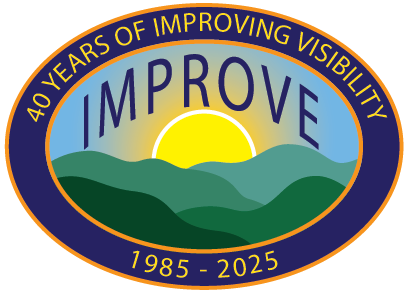Big Bend Regional Aerosol and Visibility Observational Study (BRAVO)


Background The Big Bend National Park has a diverse landscape made up of the Chihuahuan desert in which the Rio Grande has cut deep canyons within, and the Chisos Mountains which towers over the desert. The scenic beauty of this park has been spoiled over time by the increasing haze obscuring the many vistas.
The increasing haze has been a great concern to the National Park. In 1993, a U.S. and Mexico bi-national work group was created to investigate the potential impact of two large Mexican power plants, Carbon I and Carbon II, located near Big Bend. In March of 1996, this work group recommended that a comprehensive field study should be established to identify the contribution from all major sources and source regions. This recommendation led to the creation of the Big Bend Regional Aerosol and Visibility Observational Study (BRAVO). BRAVO was an intensive air quality monitoring project measuring fine aerosol mass and its constituents, atmospheric optical properties, gaseous air pollutants and meteorology from July through October 1999.
The study objectives are to:
- Quantify the impacts of major source regions and source types in both the U.S. and Mexico on Big Bend haze including: Carbon I/II power plants in Mexico; eastern Texas, eastern United States and all of Mexico.
- Determine the chemical constituents of Big Bend haze
- Determine the role of meteorology on Big Bend haze
- Identify the most likely pollutant transport corridors associated with Big Bend haze
The research objectives of the study include:
- Characterizing inorganic and organic aerosol components
- Estimating the contributions of various sources to the carbonaceous fraction of the aerosol
- Measuring the physical aerosol size distribution of fine and coarse particles
- Estimating the contributions of scattering and absorption components of Big Bend haze
- Developing relationships between particle concentrations, composition, and light scattering
- Measuring the hygroscopic properties of various aerosols.
The BRAVO study has successfully been completed and the final report is available below.
Study Data are available. The 24 hour speciated aerosol data, collected following the IMPROVE protocol, are also available from the on-line database.
Reports
Final BRAVO Report:
This is the official final report prepared by the BRAVO Technical Subcommittee for the BRAVO Steering Committee. EPA and NPS financed this study with contributions from EPRI, and staff of EPA, NPS, and the Texas Commission on Environmental Quality (TCEQ) comprised the Steering Committee. The BRAVO Study’s chief purpose was to quantify the contribution to haze at Big Bend National Park, Texas from source regions and source types in the U.S. and Mexico. This was a foundational, science-based study and not one that evaluated control strategy options. Detailed discussion of all analyses and procedures are available in the appendices and journal articles.
NPS/CIRA Final BRAVO Report:
The National Park Service (NPS) and Cooperative Institute for Research in the Atmosphere (CIRA) conducted a number of analyses to understand the physical and optical properties of haze and the contributions of source regions to Big Bend’s sulfate and haze. The source apportionment studies incorporated airmass history analyses, receptor modeling and Eulerian source oriented modeling. All source apportionment techniques and models were evaluated and validated against measured data, perfluorocarbon tracer data, and synthetic data generated from models. In addition, an extensive reconciliation of source attribution results was conducted. The reconciliation involved identifying biases in all techniques and developing a hybrid source attribution technique merging air quality data and modeling results to minimize these biases. NPS and CIRA believe these are the best available source attribution results and accurately reflect the contributions of different source regions in the United States and Mexico to Big Bend’s particulate sulfate and haze during the BRAVO study period. The implications of these results are also discussed in the report.
Study Plan: Final Program Plan for the BRAVO Study
Presentations
BRAVO Study Motivation: A slide show presenting the motivation for the studying of haze at Big Bend and the BRAVO study. This was presented at the BRAVO Public Meeting in Alpine, Texas on September 22, 2004 in the Small Theatre, Francois Fine Arts Building, Sul Ross State University 7:00 p.m. – 9:00 p.m.
Power Point File: AlpineII.ppt (2.5 mb)
Pdf file: AlpineII.pdf (0.5 mb)
BRAVO Study Results: A slide show examining the issue of haze in Big Bend NP. This is a detailed presentation that takes a person through the visibility problem at Big Bend; visibility concepts, science and regulations; and the causes of haze at Big Bend, including a summary of results from the BRAVO study. The slide show contains a number of stunning pictures of Big Bend which by them selves are worth the look.
Power Point File: BRAVO_Results.ppt (2.8 mb)
Pdf file: BRAVO_Results.pdf (4.5 mb)
Visual Air Quality in Big Bend NP: A slide show examining the issue of haze in Big Bend NP. This is a detailed presentation that takes a person through the visibility problem at Big Bend; visibility concepts, science and regulations; and the causes of haze at Big Bend, including a summary of results from the BRAVO study. The slide show contains a number of stunning pictures of Big Bend which by them selves are worth the look.
Power Point File: BigBend.ppt (5 mb)
Pdf file: BigBend.pdf (10 mb)

